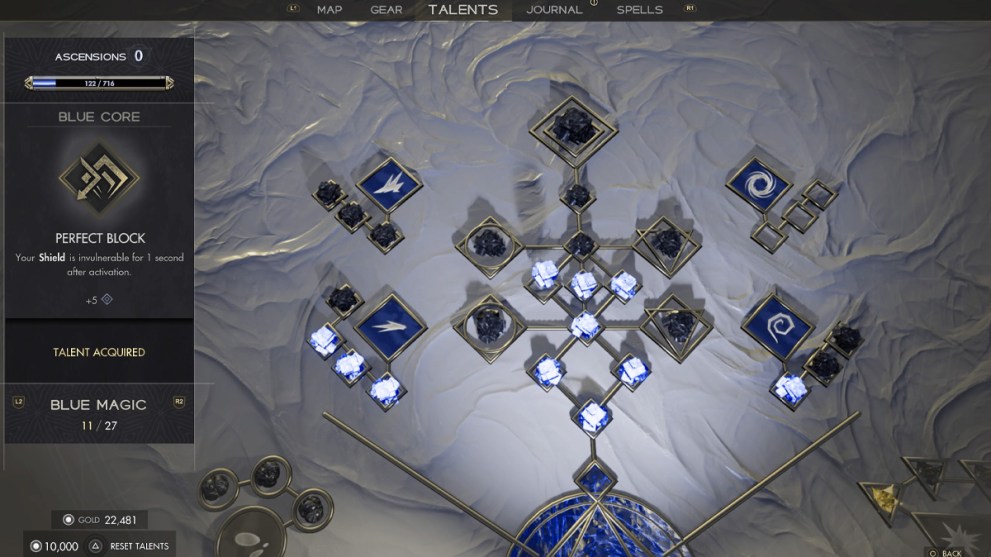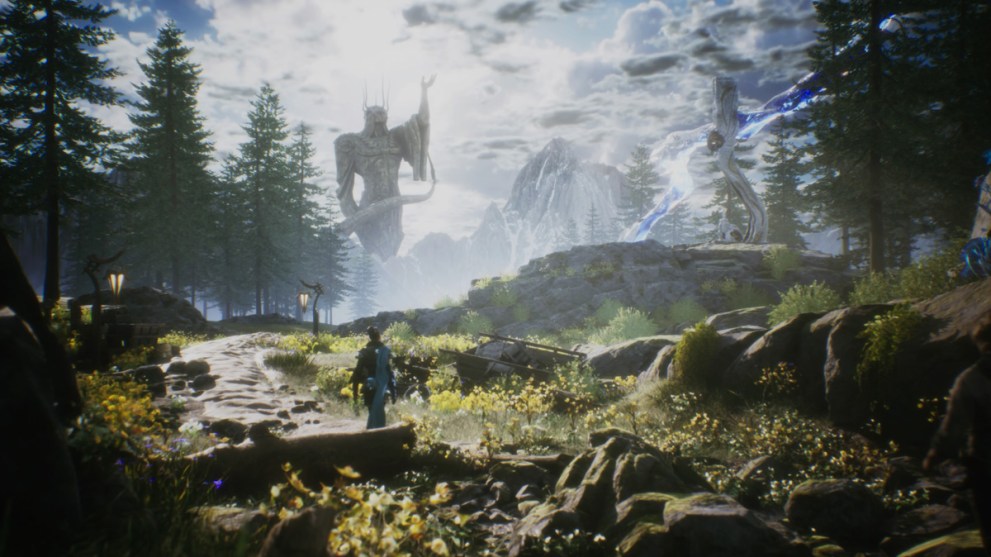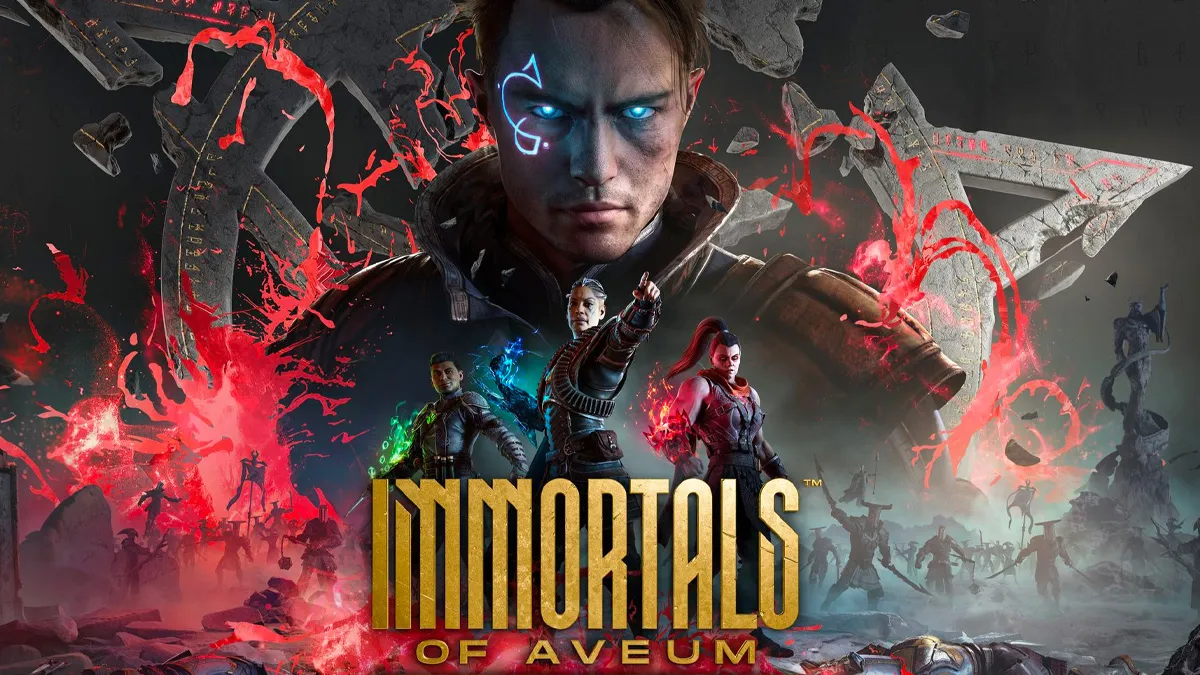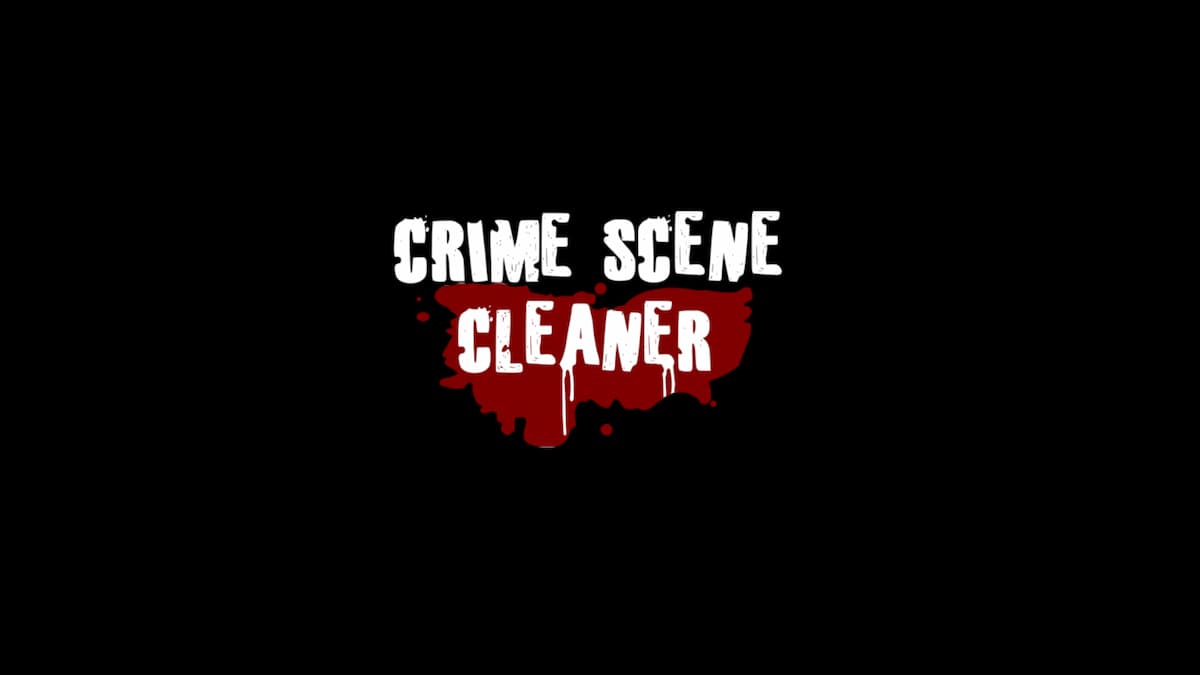Immortals of Aveum on PS5
There’s undoubtedly potential for greatness in Immortals of Aveum. It’s a unique combination of cinematic fantasy and FPS fluidity, often rendered beautifully and throwing players headfirst into immersive and rewarding combat. Unfortunately, it’s often the cause of its own mortality, struggling to balance story, lore, humor, and characters. The result is a decidedly mixed bag, a game that captivates and frustrates in equal measure.
Players are thrown into Aveum, a world that’s wounded and splintered – quite literally. Five kingdoms have collapsed into two warring superpowers, the tyrannical Rasharn and the barely surviving Lucium. Magic is at the center of these worlds, with three different types: Green, Red, and Blue. Most are confined to wielding one type but, in the case of a rare few known as Unforeseen, all can be controlled.
That’s where Jak comes in, a young protagonist hailing from Lucium and thrust into the center of the Kingdoms’ Everwar when his magical powers are revealed. He’s mighty powerful, quickly acclimatizing to his newfound abilities and devoting himself to Lucium’s cause under the command of General Kirkan.

There’s positives and negatives here. Each branch of magic is tangibly different, fitting into the FPS setting in a way that’s simultaneously familiar and distinct. Blue is the embodiment of force and the manipulation of matter, letting players fire accurate bolts, conjure robust shields and move objects. Red embodies violence, a destructive and disorienting brand of magic that I found best served close-quarters combat. Green is all about growth, death and transition, manipulating enemies and their surroundings. With access to all three, Jak is able to cycle through them based on the Sigil he wields, a metallic glove that’s upgradeable as players progress.
In fact, almost every aspect of combat is upgradeable in what’s certainly a standout gameplay element. From the aforementioned Sigils to Rings, Bracers, and Totems, nothing is off the table and players can upgrade their entire arsenal to match their playstyle. I quickly grew to favor Blue magic as a result of its accuracy and consistency, finding it the most reliable method of dealing damage to enemies. I naturally invested my time and resources (Gold and Essence, looted from around the world and rewarded upon defeating enemies) into improving my Blue magic.

However, it’s not as simple as that. The different enemies players encounter as they explore Aveum respond differently to magic. Some are immune to specific types of magic and vulnerable to others. This forced me to diversify my upgrades, ensuring I was suitably equipped for enemies that were able to shrug off Blue magic but struggled against others. It’s a smart choice from Ascendant, ensuring players can gear their game to their own preferences – but not to the degree of letting it become one note and repetitive. In fact, I found myself engaged by enemy battles throughout, with an eclectic mix of foes to defeat. It never stopped being satisfying to land critical shots and incapacitate a giant rock creature, nor eviscerating lava-dwelling crabs with Red magic’s uncompromising destruction.
There are struggles to balance quantity and quality on occasion. Some of the more challenging battles combine enemy types, throwing archers, bludgeon-ers and mobile ghost-like creatures at Jak simultaneously. While most battles let me be tactical and strategize how I’d approach the specific enemy, these quickly dissolved into a visual mess, with so little decipherable I would find myself just spam-firing with a shield equipped in the hope of vanquishing the enemies that emerged from the cacophony of color my screen had become.

I’m pleased to report this only occurred sparingly and Immortals of Aveum’s exhaustive combat is arguably the most compelling reason to play. Colorblind modes made my life much easier too (as a colorblind gamer). When I realized colored magic was at the core of its gameplay, I began to wonder if I wouldn’t struggle to discern different types of magic. Thankfully, the colorblind filter I equipped from the outset was more than sufficient in letting me get just as immersed in different colors of magic as those with eyes that function properly.
Similarly spellbinding are the worlds and environment. Jak’s missions take him far and wide across Aveum, from satanic, volcanic underworlds to freezingly intimidating glacial regions, no landscape is off the table. It lets Aveum feel deeply varied, with each of its 20 chapters obviously different from the next. Of course, there are common locations and aesthetics, but it’s layered and complex in its approach to world-building.
There are drawbacks to this, though. Players are essentially parachuted into the middle of an Everwar – aptly named because it’s been ongoing for millennia. The amount of jargon and terminology used by the characters was daunting and I felt for a long while like I was running to catch up. Even in later game moments when the story was reaching its conclusion, a lot of Jak’s objectives – relating to Stones, Fonts, Species, locations and more – were so convoluted that I couldn’t keep up. In a way I’m reluctant to criticize this aspect of the game. It’s clear that huge amounts of effort has gone into crafting a deep and immersive narrative that boasts its own history and legacies. The amount to cover is so great that I couldn’t help but feel my first playthrough, around 20 hours, was insufficient. I felt as though, rather than feeling the history and lore, I was simply being told it.

What’s more is the characters doing the telling, for the large part, are underwhelming. Hell, I even found some downright irritating. Let’s start with Jak. His ability to wield all three branches of magic makes him inherently powerful – a status he knows and isn’t afraid to let others know. I assume Ascendant were aiming for the likable and charismatic rogue, think James Bond as he disobeys M and saves the day. Frequently, though, Jak just comes across as ignorant and arrogant. I can’t really remember a video game protagonist who so frequently disregards the orders of his superiors and avoids the consequences out of luck, innate skill, or being bailed out by circumstance. There’s also random reminders of how good-looking he is, with one side character’s infatuation with Jak as out of place as it was tedious.
The side cast, largely consisting of Lucium fighters, is equally disappointing. From the physically imposing and humorless Zendara to the affable and fast-talking Devyn, they’re cliched and never really develop an endearing relationship with the protagonist, much less boast engrossing arcs of their own. The dialogue is often stilted and relies in large part on colloquialisms and incongruous humor. In a world of fantasy war and fractured Kingdoms, I was confused at Devyn’s reference to “sticky wickets”. Do they have the classic English sport of cricket in Aveum? Similarly, when I was visiting a mysterious magician to uncover vital information, I was perplexed at being told to “calm yer tits” – yes, really. It’s an interesting creative decision but, scattered among the aforementioned vernacular, it frequently took me out of tense scenes when a character tried to land an expletive-heavy one-liner.
My playthrough was also marred by some pretty significant bugs. On one occasion, I was simply unable to progress through an impassable Fortress doorway that was supposed to open as I approached. On another, a group of enemies glitched as they spawned in and I was unable to progress because I could not eliminate them and move onto the next stage of the level. Both times, my only option was to restart the chapter and play through 15 or 20 minutes of gameplay I had already completed. Fingers crossed issues like these can be eliminated swiftly after the game’s full launch, but I’m only able to review the game I played.
It’s an odd closing note, especially because I don’t think the game is obviously too short. However, I believe the main thing Immortals of Aveum would benefit from is a narrative a lot longer than it is. Perhaps the combat would get repetitive and perhaps it’s the misfortune of launching so close to the incredible (and long) Baldur’s Gate 3. Either way, there’s so much story here to tell, so much lore to explore and so many characters that just need more. Another 10, 15 or even 20 hours would have let Ascendant do all of that.
Immortals of Aveum, in some areas, is a major success. A wonderfully crafted and frequently beautiful word is the perfect backdrop to enjoy its excellent combat system that’s as detailed as it is spellbinding. In others, it’s a frustrating case of overly-complex lore, a mediocre cast and a borderline dislikable protagonist. The result is a game that’s fun, if some way off as emotionally investing as it could – and maybe should – have been.
- Spellbinding combat.
- Beautiful and layered world.
- Rewarding progression system.
- Mediocre characters.
- Bugs and glitches forcing replays of completed gameplay.
- Struggle to balance story and lore.













Updated: Aug 21, 2023 05:58 am